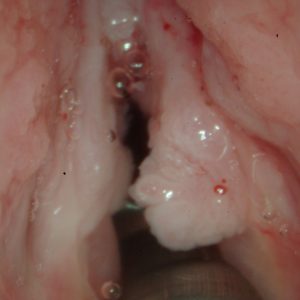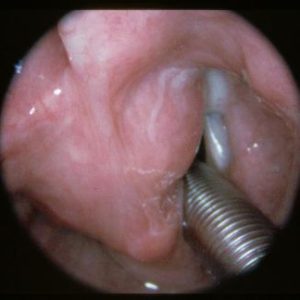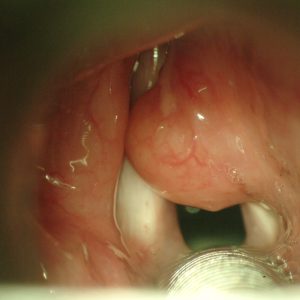Laryngeal papillomas are small, wart-like growths that develop in the voice box (larynx) due to the human papillomavirus (HPV). These growths can cause hoarseness, difficulty breathing, and a rough or strained voice. While papillomas are not cancerous, they can grow back even after treatment, sometimes requiring repeated procedures. Children and adults can both develop laryngeal papillomas, with young children often having more severe cases.
Treatment usually involves in-office or surgical removal of the growths using lasers or other specialized tools. Sometimes, doctors may use medications to help slow down their return. Patients might need multiple treatments to keep their airway clear and improve their voice. Recovery depends on the extent of the procedure, but most patients experience a noticeable improvement in their voice shortly after treatment. Regular follow-ups are essential to monitor for regrowth.

Papilloma

Papilloma
Verrucous lesions are rough, wart-like growths on the vocal cords that can make the voice sound hoarse, weak, or breathy. These lesions are often caused by long-term irritation, such as smoking, acid reflux, or chronic vocal strain. Some verrucous lesions are harmless, but others may be linked to early-stage cancer, making proper diagnosis important.
Doctors typically examine the vocal cords using a camera-based procedure called laryngoscopy to determine the nature of the lesion. If needed, a biopsy is performed to rule out cancer. Treatment depends on the cause, but options may include laser removal, voice therapy, and lifestyle changes like quitting smoking or managing acid reflux. Recovery varies, but patients usually experience voice improvement within weeks after treatment.
Laryngoceles are air-filled sacs that develop in the larynx. They can be internal, staying within the voice box, or external, extending outward. These sacs form when mucus glands become blocked or due to increased pressure from activities like playing wind instruments or frequent coughing. If external, laryngoceles can cause hoarseness, breathing difficulties, or a visible lump on the neck.
Treatment depends on the severity of symptoms. Small, non-bothersome laryngoceles may not need treatment, but larger ones that affect breathing or cause discomfort might require surgical drainage or removal. Most patients recover well with minimal complications, and follow-up care ensures that the problem does not return.

Laryngocele
Saccular cysts are fluid-filled sacs that develop in a small pocket of the voice box called the saccule. If they grow too large, they can block normal vocal cord movement, leading to hoarseness, throat discomfort, or even breathing problems. They may form due to mucus buildup or previous infections.
Doctors diagnose saccular cysts using imaging tests or direct examination with a scope. Depending on the cyst's size and location, treatment usually involves surgical removal in an office setting or the operating room. Recovery is generally smooth, with most patients noticing improvements in their voice and breathing soon after the procedure. Voice therapy may be recommended if the cyst affects vocal cord function.

Saccular Cyst

 YouTube Channel
YouTube Channel
